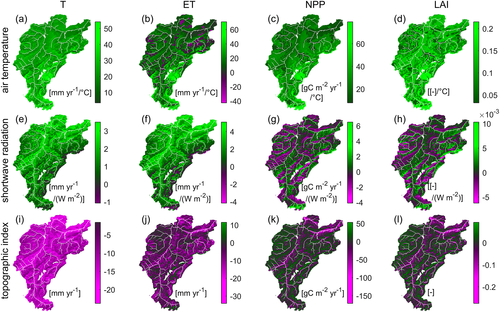ALPHSENS - A pan-Alpine high-resolution carbon and water budget and its sensitivity to climate changes
Dates: 2016-2019
Funding: ETH Grants
PhD Student: Theodoros Mastrotheodoros
Principal Investigator: Simone Fatichi
The European Alps are often called the "water towers" of Europe, providing water to four major European rivers, the basins of which are populated by more than 170 million people. Large scale ecohydrological simulation models are rarely applied at these scales, yet these are the scales at which predictions of water and carbon budgets under future climatic conditions have to be made. In this reasearch we exploited such large-scale simulations, and we studied details of the plant-scale parameterisations, topographic and soil parameter effects in the model used (T&C).
More green and less blue water in the Alps during warmer summers

Climate change can reduce runoff into streams by enhancing evapotranspiration in forested mountains, especially during heatwaves. We investigated this "drought paradox" for the European Alps using a 1,212-station database and hyper-resolution ecohydrological simulations with the T&C Ecohydrological Model to quantify blue (runoff) and green (evapotranspiration) water fluxes. We showed that during the 2003 heatwave, evapotranspiration in large areas over the Alps was above average despite low precipitation, amplifying the runoff deficit by 32% in the most runoff-productive areas at 1,300–3,000 m. A 3 °C air temperature increase could enhance annual evapotranspiration by up to 100 mm (45 mm on average), which would reduce annual runoff at a rate similar to a 3% precipitation decrease. This suggests that green-water feedbacks pose an additional threat to water resources, especially in dry summers, even though precipitation deficits still dominate runoff anomalies.
Mastrotheodoros, T., Pappas, C., Molnar, P. et al. (2020), external page More green and less blue water in the Alps during warmer summers. Nat. Clim. Chang. https://doi.org/10.1038/s41558-019-0676-5.
Plant-scale and basin-scale effects on ecohydrological simulations

Elevated atmospheric CO2 concentrations are expected to enhance photosynthesis and reduce stomatal conductance, thus increasing plant water use efficiency (IWUE). In this research at the plant scale we tested the hypothesis that observed IWUE increases could be attributed to interannual trends in plant functional traits, potentially triggered by environmental change. We found that IWUE increased by ~1.3% yr−1, which is less than previously reported but still larger than theoretical expectations. Numerical simulations with the T&C Ecohydrological Model showed that only simulations with plant functional trait plasticity match the observed trends in IWUE. At the basin scale we quantified the drivers of ecosystem functioning and explored the vulnerability of Alpine ecosystems to climate change with the same model in real and synthetic landscapes. We quantified spatially explicit sensitivities of net primary productivity, transpiration, and snow cover to air temperature, radiation, and water availability driven by topography. This research points to the fact that plant-level details and small-scale climatic and topographic variability may potentially strongly influence forest water, carbon, and energy fluxes and their representation in Earth system models.
Mastrotheodoros, T., et al., (2017), external page Linking plant functional trait plasticity and the large increase in forest water use efficiency, J. Geophys. Res. Biogeosci., 122, 2393–2408, doi:10.1002/2017JG003890.
Mastrotheodoros, T., et al. (2019), external page Ecohydrological dynamics in the Alps: Insights from a modelling analysis of the spatial variability, Ecohydrology, 12:e2054, https://doi.org/10.1002/eco.2054.